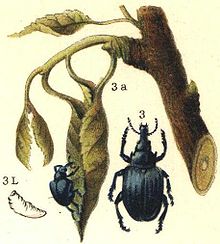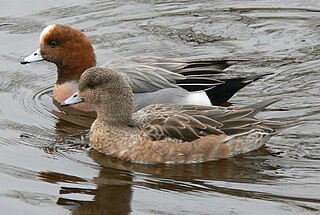
The Eurasian wigeon or European wigeon, also known as the widgeon or the wigeon, is one of three species of wigeon in the dabbling duck genus Mareca. It is common and widespread within its Palearctic range.

The white-cheeked pintail, also known as the Bahama pintail or summer duck, is a species of dabbling duck. It was first described by Carl Linnaeus in his landmark 1758 10th edition of Systema Naturae under its current scientific name.

The common redshank or simply redshank is a Eurasian wader in the large family Scolopacidae.

The pied avocet is a large black and white wader in the avocet and stilt family, Recurvirostridae. They breed in temperate Europe and across the Palearctic to Central Asia then on to the Russian Far East. It is a migratory species and most winter in Africa or southern Asia. Some remain to winter in the mildest parts of their range, for example in southern Spain and southern England. The pied avocet is one of the species to which the Agreement on the Conservation of African-Eurasian Migratory Waterbirds (AEWA) applies.

Systema Naturae is one of the major works of the Swedish botanist, zoologist and physician Carl Linnaeus (1707–1778) and introduced the Linnaean taxonomy. Although the system, now known as binomial nomenclature, was partially developed by the Bauhin brothers, Gaspard and Johann, Linnaeus was first to use it consistently throughout his book. The first edition was published in 1736. The full title of the 10th edition (1758), which was the most important one, was Systema naturæ per regna tria naturæ, secundum classes, ordines, genera, species, cum characteribus, differentiis, synonymis, locis or translated: "System of nature through the three kingdoms of nature, according to classes, orders, genera and species, with characters, differences, synonyms, places".

The brown hairstreak is a butterfly in the family Lycaenidae. The range includes most of the Palaearctic.
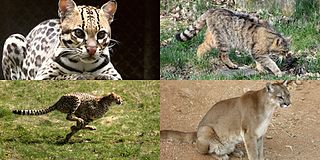
The Felinae are a subfamily of the family Felidae. This subfamily comprises the small cats having a bony hyoid, because of which they are able to purr but not roar.

Ardea is a genus of herons. These herons are generally large in size, typically 80–100 cm or more in length.

Acronicta is a genus of noctuid moths containing about 150 species distributed mainly in the temperate Holarctic, with some in adjacent subtropical regions. The genus was erected by Carl Linnaeus in his 1758 10th edition of Systema Naturae. Caterpillars of most Acronicta species are unmistakable, with brightly colored hairy spikes, and often feed quite visibly on common foliate trees. The hairy spikes may contain poison, which cause itchy, painful, swollen rash in humans on contact. The larva of the smeared dagger moth is unusually hairy even for this genus. Acronicta species are generally known as dagger moths, as most have one or more black dagger-shaped markings on their forewing uppersides. But some species have a conspicuous dark ring marking instead.

The genus Cathartes includes medium-sized to large carrion-feeding birds in the New World vulture (Cathartidae) family. The three extant species currently classified in this genus occur widely in the Americas. There is one extinct species known from the Quaternary of Cuba.
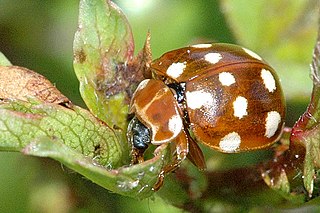
Calvia quatuordecimguttata, the cream-spot ladybird, is a species of ladybird in the family Coccinellidae. Its distribution is holarctic, it being found in Europe and through the East Palearctic to Japan. It is introduced to North America. This ladybird is generally 4 to 5 millimetres in length and varies in appearance depending on the geographical location. It usually lives in hedgerows and deciduous trees.
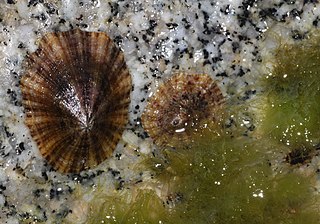
Patella caerulea, is a species of limpet in the family Patellidae. It is known by the common names Mediterranean limpet and rayed Mediterranean limpet. It is native to the Mediterranean Sea.
In the 10th edition of Systema Naturae, Carl Linnaeus classified the arthropods, including insects, arachnids and crustaceans, among his class "Insecta". True bugs and thrips were brought together under the name Hemiptera.
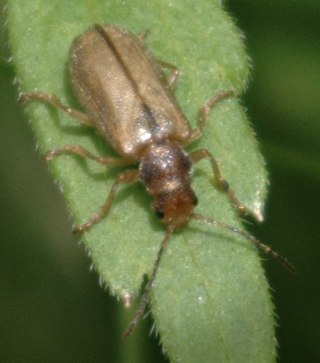
Syneta is a genus of leaf beetles in the subfamily Synetinae. There are about 11 described species in Syneta. The genus is entirely holarctic in distribution, with species appearing in North America, Siberia, East Asia and Northern Europe.
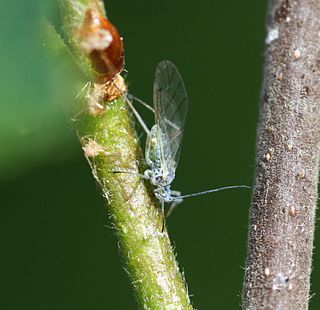
Euceraphis betulae, the birch aphid or silver birch aphid, is a species of aphid in the order Hemiptera. It is a tiny green insect with a soft body and wings. It is found living on the European silver birch tree where it feeds and multiplies on the buds and leaves by sucking sap.
Trypodendron betulae, the birch ambrosia beetle, is a species of typical bark beetle in the family Curculionidae. It is found in North America. It has a symbiotic relationship with Ambrosiella fungi.
Deporaus glastinus is a species of leaf rolling weevil in the beetle family Attelabidae. It is found in North America.
Phytobia betulae is a species of fly in the family Agromyzidae. It is native to Northern and Eastern Europe, being common in Scandinavia. Its larvae tunnel through the branches and trunk of birch trees, often leaving a dark stain in the timber but not adversely affecting the tree's growth.

Phytobia is a genus of flies in the family Agromyzidae, with a worldwide distribution principally in Europe and the Americas.

Amanita betulae is a species of Amanita found in growing in birch and mixed hardwood in Europe

